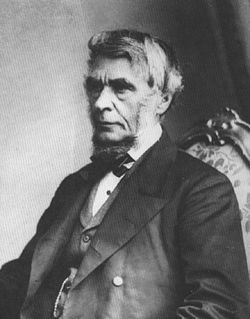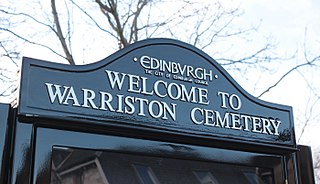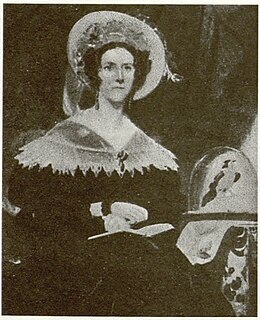Related Research Articles

The Dean Cemetery is a historically important Victorian cemetery north of the Dean Village, west of Edinburgh city centre, in Scotland. It lies between Queensferry Road and the Water of Leith, bounded on its east side by Dean Path and on its west by the Dean Gallery. A 20th-century extension lies detached from the main cemetery to the north of Ravelston Terrace. The main cemetery is accessible through the main gate on its east side, through a "grace and favour" access door from the grounds of Dean Gallery and from Ravelston Terrace. The modern extension is only accessible at the junction of Dean Path and Queensferry Road.

Sir Joseph Dalton Hooker was a British botanist and explorer in the 19th century. He was a founder of geographical botany and Charles Darwin's closest friend. For twenty years he served as director of the Royal Botanical Gardens, Kew, succeeding his father, William Jackson Hooker, and was awarded the highest honours of British science.

George Bentham was an English botanist, described by the weed botanist Duane Isely as "the premier systematic botanist of the nineteenth century". Born into a distinguished family, he initially studied law, but had a fascination with botany from an early age, which he soon pursued, becoming president of the Linnaean Society in 1861, and a fellow of the Royal Society in 1862. He was the author of a number of important botanical works, particularly flora. He is best known for his taxonomic classification of plants in collaboration with Joseph Dalton Hooker, his Genera Plantarum (1862–1883). He died in London in 1884.

Sir William Jackson Hooker was an English botanist and botanical illustrator, who became the first director of Kew when in 1831 it was recommended to be placed under state ownership as a botanic garden. At Kew he founded the Herbarium and enlarged the gardens and arboretum. The standard author abbreviation Hook. is used to indicate this person as the author when citing a botanical name.

Asa Gray is considered the most important American botanist of the 19th century. His Darwiniana was considered an important explanation of how religion and science were not necessarily mutually exclusive. Gray was adamant that a genetic connection must exist between all members of a species. He was also strongly opposed to the ideas of hybridization within one generation and special creation in the sense of its not allowing for evolution. He was a strong supporter of Darwin, although Gray's theistic evolution was guided by a Creator.

John Forbes Royle, British botanist and teacher of materia medica, was born in Kanpur in 1798. He was in charge of the botanical garden at Saharanpur and played a role in the development of economic botany in India.
Robert William Lawrence (1807–1833), first-born son of William Effingham Lawrence, was born and educated in England. In 1825 he arrived in Van Diemen’s Land (Tasmania). He became acquainted with Sir William Jackson Hooker, the Regius Professor of Botany at the University of Glasgow and later director of the Botanical Gardens at Kew in London, from whose friendship he developed a passion as an amateur botanist, sending many specimens from the Colony to Kew, resulting in Hooker’s "Flora Tasmaniae" in 1860. Lawrence was Tasmania’s first botanist, and introduced Ronald Campbell Gunn to Hooker. The native fuchsia mountain correa was named by Hooker Correa lawrenciana in honour of his young protégé.

Ronald Campbell Gunn, FRS, was a South African-born Australian botanist and politician.

Dawson Turner was an English banker, botanist and antiquary. He specialized in the botany of cryptogams and was the father-in-law of the botanist William Jackson Hooker.

George Arnott Walker-Arnott of Arlary was a Scottish botanist.
Archibald Campbell of the Bengal Medical Service was the first superintendent (1840-1862) of the sanatorium town of Darjeeling in north east India. He also took a great interest in ethnology, economic botany and the study of the region and wrote extensively in the Journal of the Asiatic Society of Bengal under the name of "Dr Campbell" or "Dr A. Campbell" which has led some authors to misidentify his first name as Arthur or even Andrew. Campbell is credited with the introduction of tea cultivation in Darjeeling and for playing a role in the early experiments on the cultivation of Cinchona. Campbell corresponded with numerous naturalists including B.H. Hodgson and Sir Joseph Hooker. The latter travelled around Sikkim with Campbell on an expedition in which the two were held prisoner by Tsugphud Namgyal, the local ruler. This incident led to the British annexation of the Sikkim Terai region.
William Hooker may refer to:

Warriston Cemetery is a cemetery in Edinburgh. It lies in Warriston, one of the northern suburbs of Edinburgh, Scotland. It was built by the then newly-formed Edinburgh Cemetery Company, and occupies around 14 acres (5.7 ha) of land on a slightly sloping site. It contains many tens of thousands of graves, including notable Victorian and Edwardian figures, the most eminent being the physician Sir James Young Simpson.
Julius Rudolph Theodor Vogel was a German botanist.

James Smith of Jordanhill FRSE FRS MWS (1782–1867) was a Scottish merchant, antiquarian, architect, geologist, biblical critic and man of letters. An authority on ancient shipbuilding and navigation, his works included "Newer Pliocene" (1862) and "Voyage and Shipwreck of St Paul" (1848).

Christian Ramsay, Countess of Dalhousie informally Lady Dalhousie, néeBroun; was a Scottish botanist and natural historian. She married George Ramsay, 9th Earl of Dalhousie and travelled with him when he was appointed Lieutenant Governor of Nova Scotia, Governor General of Canada and Commander in Chief of the Indian Army. While travelling, she collected and catalogued many species of plants, presented scientific papers to societies and donated many collections to different botanical groups.

The Ross expedition was a voyage of scientific exploration of the Antarctic in 1839 to 1843, led by James Clark Ross, with two unusually strong warships, HMS Erebus and HMS Terror. It explored what is now called the Ross Sea and discovered the Ross Ice Shelf. On the expedition, Ross discovered the Transantarctic Mountains and the volcanoes Erebus and Terror, named after his ships. The young botanist Joseph Dalton Hooker made his name on the expedition.
References
- 1 2 3 4 "William Dawson Hooker". The University of Glasgow Story. University of Glasgow. Retrieved 18 July 2016.
- ↑ "University Chairs" (PDF). Strathclyde University. Retrieved 18 July 2016.
- ↑ Hooker, J.D. (2 August 1879). "Dear Gray". Letter to Asa Gray. Retrieved 18 July 2016.